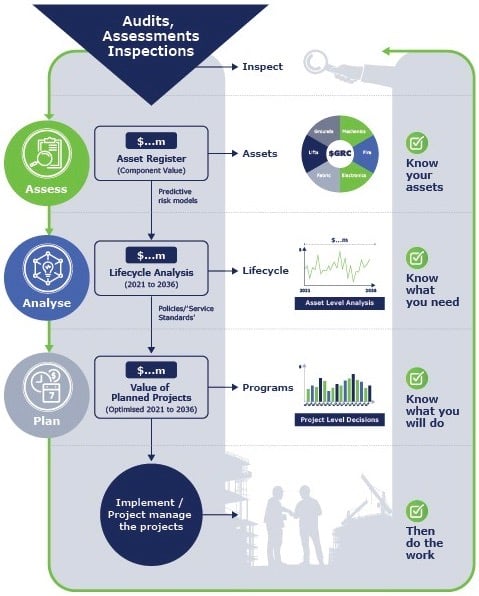NAMS Property eManual for long-term thinking
The case for long-term thinking

Long-term thinking needs to be at an organisational level and be embedded so that as key people come and go, the process endures and ensures the buildings are cared for in a way that could make them last forever.
Yet when times get tough economically, financially or politically, one of the first things to go is often the planning budget, because shorter-term ‘cost savings’ can be achieved through simply turning to a reactive maintenance approach. This is true in both government and commercial asset portfolios. Whether buildings are there for producing income, or providing community facilities, property owners benefit from long-term thinking. Recognising the value in this, how do we think and plan long-term in a consistent way between different industries?
IPWEA provides long-term planning guidance for all industries
The Institute of Public Works Engineering Australasia (IPWEA) provides long-term planning guidance to organisations across different industries. Their initial expertise was aimed at Councils, in response to legislation around asset management plans – the resulting lifecycle renewal projections were first seen in the mid-1990s and some were so high that they created shock waves in the sector. This highlighted the importance of looking after existing assets and the risks associated with their neglect.
Asset management planning processes were introduced across a range of social infrastructure assets and provided a consistent and proven way to plan long-term where there are many unknowns. Whilst it took a few years to establish, the resulting early identification and funding of renewal and improvement work started to be recognised by organisations. This is proving its worth through minimising the risk of asset failures and maintaining an affordable and achievable level of service to the community and customers.
The International Infrastructure Management Manual (IIMM), published by IPWEA, provides industry-leading guidance on how to align with ISO 55000 - the international standard for asset management. It originally focused on roads, sewerage, water and storm water. Although the IIMM had been updated to include great content for property asset managers, it was still a manual used mainly by infrastructure asset managers. Due to the wide range of property-intensive industries that saw the value in applying infrastructure planning principles to building assets, the NAMS Property manual was written over a period of four years: a time that proved to be worth the wait, as the manual has stood the test of time.
The underlying goals of the steering group for NAMS Property were as follows:
- Have property on the ‘strategic agenda’ of organisations.
- Recognise that property provides real long-term value to organisations, rather than being seen as a cost centre.
- Further, elevate the knowledge and skills of property asset managers to help them think long-term.
- Move from a reactive to planned maintenance approach to looking after buildings.
- First, understand the services provided and use of the building; then understand the assets.
- Communicate that buildings can last forever if they are needed forever – and if the right standards, policies and processes are applied.
A former New Zealand Auditor General, Kevin O’Brady described the NAMS Property Manual: "I believe the application of the asset management planning process within this guideline will considerably enhance the long term prudent management of property assets within Local Government. Its asset management principles will also add value to other entities involved in the public sector which utilise special purpose property assets. The principles also warrant attention for entities outside the public sector for the benefits they may provide to their property asset management.”
With the eManual being embraced by many organisations over the years, from 2021 IPWEA has embarked on a refresh and rethink about how building intensive organisations can gain value from the eManual. The first stage is to produce a manual specifically for the community and social housing industry – the project managed by RMIT, supported by AHURI and distributed by both IPWEA and the AHI (Australasian Housing Institute). In time, other industry-specific manuals will also be produced.
The NAMS Property eManual is provided through IPWEA. Or Email our Support team if you are unsure how to access it.
Global support: support@spmassets.com
Australian support: support@spmassets.com.au
Subscribe to our Broadcast
Our monthly newsletter featuring asset management tips and insights, and the latest SPM Assets news.